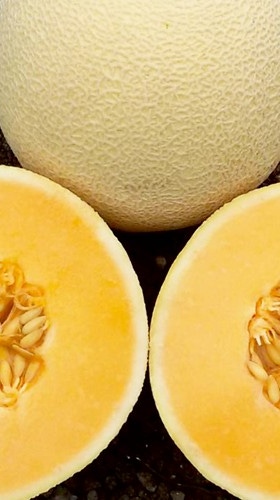Melon Disease Management
Gummy Stem Blight

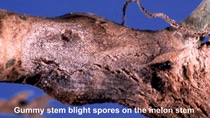
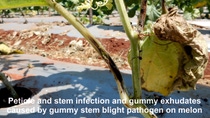
Gummy Stem Blight:
Causal Agent: Stagonosporopsis cucurbitacearum; (previously, Didymella bryoniae). Also known by the asexual state, Phoma cucurbitacearum.
Distribution: Worldwide
Identification:
Gummy stem blight causes ovate stem and vine cankers, usually starting near the nodes, with a characteristic brown gummy exudate. Within advanced lesions on dead tissue, small black fungal fruiting bodies, known as pycnidia. Pycnidia contains pathogen conidia. Leaves can exhibit dark brown circular spots starting at margins and rapidly spreading to entire leaf. These foliar lesions can vary in color from light brown to nearly black. Black rot infected fruits show small water-soaked spots that advance into large brown spots, sometimes also exhibiting the brown gummy secretion as found in stems.
Life Cycle/ Favourable Environmental conditions for the disease:
Gummy Stem Blight occurs throughout India. Temperature and moisture are the most important factors in the spread of Gummy Stem Blight. For Melon, the best temperature for infection is around 25 °C. Continuous leaf wetness from 2-10 hours is necessary for germination, sporulation, and colonization of conidia. After infection occurs, large brown lesions will retain moisture for long periods of time. Even though it takes constant moisture to facilitate the pathogen, it is highly resistant to dry conditions and can survive as chlamydospores for over a year in dry organic debris.
Disease transmission:
The pathogen survives on surrounding weeds, or organic debris from previously infected cucurbits. Without a host, the pathogen is able to overwinter and survive for over a year as chlamydospores, hardened masses of hyphae that act as survival structures during dry or adverse conditions. The pathogen is transferred from infected hosts to healthy plants via ascospores carried in the wind and by conidia that are released from pycnidia by water splash and in gummy exudate. They can survive for up to 2 years. Spread is by splashing water, wind-driven rain, and on fingers, knives, and clothing during cultural operations. Development of the disease depends on how long the leaves, stems and fruits stay wet so that spores can germinate, infect, and for the fungus will continue to grow.
Control:
1. After planting, check the seedling at least twice a week. If spots are seen on the leaves, remove them to delay the spread of the disease.
2. Avoid overhead irrigation as water splash spreads this fungus, or if overhead irrigation is used, apply early in the day so that the plants dry quickly.
3. Harvest carefully, cutting the fruit from the vine; do not pull them off. Sterilize the knife frequently by wiping it in 1% bleach.
4. Remove wilted or dead leaves frequently as they may contain spores of the fungus.
5. Remove weeds, so air can circulate around the plants to helping for the drying of wet leaves.
6. Collect and burn, bury, or compost the debris as soon as the harvesting is completed. The fungus can remain alive in stems, in the soil surface for several months and release spores at favorable condition.
7. Do not plant cucumbers, where cucurbits were grown previously. Leave a break of three years. The fungus can survive in the soil and plants remains.
8. Rotate the crop with non-cucurbits crops.
9. Avoid injuries during fruit harvesting, packing and storage.
Powdery Mildew
Causal Agent: Podosphaera xanthii
Distribution: Worldwide
Identification:
P. xanthii grows on the outside of leaves, first appearing as a small, circular, yellow lesions on leaves and petiole. Lesions quickly become covered in white spores and may appear also on the underside of the leaf, white growth, eventually becoming a layer of white fluffy mycelium and spores on the upper or lower side of leaves. P. xanthii does not grow systemically., instead this fungus prefers to produce mycelium on the outer surface and penetrate the leaves with specialized feeding cells called haustoria. The fungus will then produce spores in the absence of free water; spore production gives the leaves the characteristic powdery appearance. The spores are spread to new infection sites by wind. After the fungus has extracted nutrients, the plant cells die, causing the leaves to become brown and papery. Fruit produced by the plant may accumulate less sugar, have reduced yield.
Life Cycle/ Favourable Environmental conditions for the disease:
The optimal conditions for powdery mildew growth are temperatures between 20 to 26°C and shady conditions. P. xanthii prefers dry conditions, with relative humidity of 50 percent to 90 percent for spore production, dense foliage and irrigation may create microclimates that favor powdery mildew development. However, presence of water on the plant surface may wash off and/or inhibit the germination of the fungal spores.
Disease transmission
The pathogens generally overwinter on weeds and their spores can be carried to long distances by air currents. The pathogen survives via conidia carried by wind over long distances.
Control:
1. Use of resistant cultivars, if available.
2. Give sufficient /adequate plant spacing for good air movement.
3. Remove debris, weeds, and volunteers that may harbor the pathogen
4. Application of fungicides to protect the crop
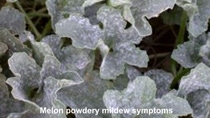
Downy Mildew
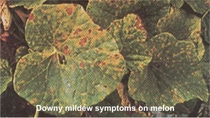
Causal Agent: Pseudoperonospora cubensis
Distribution: Worldwide
Identification:
Initially spots are light yellow with a dark green border that appears water soaked. The spots enlarge and become brown (necrotic). They are not angular like symptoms on cucumber. When conditions are favorable, for example early in the morning when moisture is higher, lesions observed on the underside of the leaf may be covered in dark “down”. This downy growth is masses of pathogen spores called sporangia, which can be seen in the field with a 20X hand lens. In the presence of water sporangia can directly germinate or differentiate into swimming zoospores that infect leaves.
Life Cycle/ Favourable Environmental conditions for the disease:
Pseudoperonospora cubensis causes a polycyclic disease. Sporangia are the source of primary inoculum. Sporangia are transported from infected plants via wind currents and travel to local or distant places. Optimal temperature for sporulation is 15˚C with 6 to 12 hours of available moisture. Symptomatic plants with yellow lesions have the greatest sporulating capacity. Sporangia and sporangiophores are greatly affected by changes in temperature and humidity. symptoms appear 3-12 days after infection, depending on temperature, presence of free moisture and inoculum dose. High temperatures (>35ºC) are not favorable for disease development. However, if cooler nighttime temperatures occur, disease development may progress.
Control:
1. Plant early in the season to escape high disease pressure
2. Do not allow water to remain on leaves for long periods of time
3. Downy mildew severity can be decreased by taking actions that encourage airflow and reduce leaf wetness.
4. Scout plants often and remove the infected plants.
5. Field sanitation by burning crop debris to reduce the inoculums.
6. Decrease moisture in the plant canopy.
7. Plant tolerant varieties, if available
8. Protect the crop with fungicides.
Fusarium Wilt
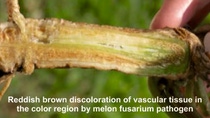
Causal Agent: Fusarium oxysporum f. sp. melonis
Distribution: Worldwide
Identification:
Although plants may be affected in any stage of development, the most common expression is on mature plants. On young seedlings, a hypocotyl rot and damping-off may occur. In older plants, there is marginal yellowing progressing to a general yellowing of the older leaves and wilting of one or more runners. In some cases, sudden collapse occurs without any yellowing of the foliage. On stems near the crown of the plant, a linear, necrotic lesion may develop, extending up the plant and usually on one side of the vine. Vascular discoloration very evident and is very diagnostic. Mature plants often wilt severely (collapse) late in the season because of the fruit load stress. Fusarium wilt collapse should not be confused, however, with sudden wilt of melon. Sudden wilt is a complex disease associated with plant stresses by heavy fruit set, cool soil temperatures followed by warm and sunny days, feeder root loss caused by soilborne fungi (may include Verticillium and other species).
Life Cycle/ Favourable Environmental conditions for the disease:
Fom survives in the soil as chlamydospores, which are thick-walled modifications of the mycelium. The local spreading of the pathogen occurs primarily via movement of infested soil and plant debris. Infection of the host occurs by penetration of the root, primarily in the area of elongation, and is aided by wounds. Root-feeding larvae of the striped cucumber beetle may increase the incidence of wilt and also reduce the number of Fom propagules necessary to induce wilt.
Environmental and soil conditions are important for infection and in symptom expression. Disease severity is maximum at soil temperatures of 25-27 °C and declines dramatically above 32 °C. At high soil temperatures, plants become infected but may not wilt; rather they develop severe stunting. As with most Fusarium wilts, the following apply: 1) low soil moisture favors the pathogen and increases the wilting symptom; 2) high nitrogen, especially ammonium nitrogen, and light, sandy, slightly acidic soils (pH 5-5.5) favor disease development; and 3) liming the soil to increase the pH to 6.5-7.0 decreases wilt severity.
Control:
1. Crop rotations. Watermelons should never be grown in succession on the same land.
2. Soil Fumigation. Moderate reductions in disease severity have been observed with commercial soil treatment products
3. Soil solarization. Soil solarization is the use of clear plastic mulch placed over fallow soil during the hot months of the year in order to trap the energy from the sun and heat the soil to temperatures that are lethal to the pathogen.
